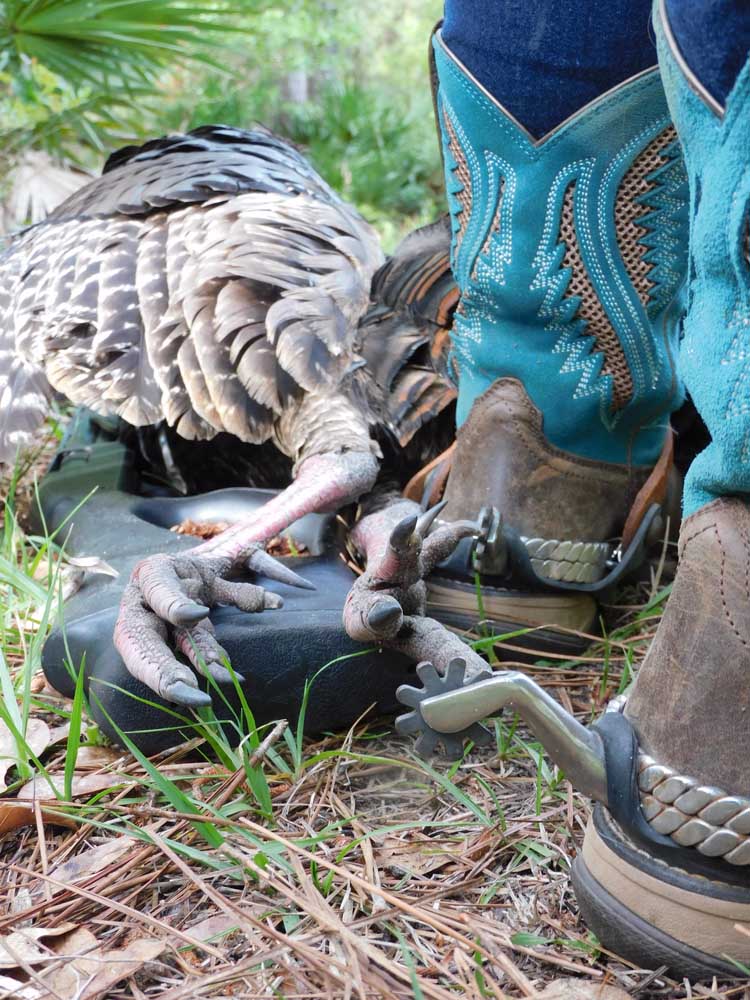Outdoors: Osceola turkey and a running fight in the swamp
Published 1:30 pm Monday, May 1, 2023

- An Osceola gobbler taken on a hunt near Middleburg, Florida.
There’s a quarter-mile of road left that used to connect old Gainesville in the interior to St. Augustine on the coast. We turned on to the forgotten track and parked under the cypress and pines. Middle of the day, Middleburg, Florida.
A few strands of wire marked out the bounds of an old graveyard.
Teddy Spencer took off his hat and wiped his brow. “They were all just fighting for their country,” he said.
We walked among the tilted headstones, stooped to read the names and the dates hidden in the moss. Here a Civil War veteran that lived to old age, here his wife, and here a 2-year-old daughter. Teddy gestured with his hat. “The oldest graves are in the back, Union men. There used to be markers, but you can still see where the graves sink in.”
Fellow outdoor writer Troy Rodakowski, of Junction City, and Trevor Barclay, of Redmond, had traveled with me across the country in pursuit of the Osceola turkey; part of what we call the Turkey Slam, which includes the Rio Grande, Merriam’s and the Eastern subspecies. Now we tiptoed out of the graveyard where the rattlesnake trails slithered out of the gopher holes.
We were here because of a chance meeting with Marsha Spencer and her daughter Yvonne Bowlin in Titusville last year. And because Troy had called me one night to tell me he had a heart attack and it scared him and he realized he still had turkeys to chase; he needed an Osceola and an Eastern to finish his slam. “I’m not getting any younger,” he said.
This cemetery was where the war ended for at least a dozen soldiers way back in October 1864. When Union soldiers took control of the St. Johns River, the 4th Massachusetts Cavalry established an outpost in Magnolia and raided Middleburg setting fire to warehouses, docks and a hotel. But Capt. J.J. Dickison pushed the 4th Massachusetts across Blacks Creek and the Federal retreat turned into a rout when Dickison cut them off. The final battle lasted less than 40 minutes and a dozen Federals were killed, 9 wounded and 15 or so captured.
We set up an ambush for a pair of long-legged Osceola gobblers on the banks of Black’s Creek and they almost walked right in, but detoured toward their roosts. In the morning we went back. We heard the fly-down gobbles at dawn and saw two red heads come out of creek bottom. Teddy and Troy called one out into the open while another one lagged back. The gobbler in the lead stopped, not seeing a hen; and when it looked like the longbeard would duck and run, Troy put his cheek on the stock, lined up the bead and dropped it in its tracks. We stepped off Troy’s shot at 35 yards. The other gobbler got to keep its spurs.
Spring comes earlier to Florida and Florida’s turkey season starts in March. The gobblers were already wise when we got there in mid-April.
We called on forest roads, glassed turkeys across meadows, brushed in our swamp blinds with palmetto, ate Vienna sausages for lunch and feasted at nights. It couldn’t be a turkey hunt without a low-country boil — Poppa Frank leaned back in his chair and Tommy and me poured shrimp and crab legs and sausage, corn and taters out on the tablecloth.
Finally on a late morning on a powerline road we spotted a pair of big gobblers and nine or 10 jakes. All legal birds, but there was one tom with a 9-inch beard and another that was longer.
I was inside a culvert with Trevor behind me with the camera when Teddy and Troy began to call. At first one gobbler moved toward us, but it was like he was running in place. He looked to have taken a hundred steps, but hadn’t moved more than 3 feet until the jakes began to run. Now on came the whole troop.
The younger yearling males fought and jousted. In the pack of birds, I tried to keep my eye on the two gobblers. One got nervous and stopped while the other came on and strutted. I flat missed him with a load of No. 4s. That was 2½ days into the hunt with 2½ days left to go.
When, after miles in our boots and hours in the blinds, two jakes crossed the road in front of us, I knew it was over. A jake afforded an easy chance at 20 yards, its head up above the grass, its paintbrush of a beard sticking straight out. I let him walk. Yah, I still need that Osceola turkey.
Here in Oregon, it is early in our late spring with the wildflowers popping and birds gobbling from the roost and strutting for hens.
Wherever we go there are old roads, and if we look, the traces of the hunters that passed before. Our history is being hidden between the highways and buried beneath the strip malls. But the clues are there that tell the stories of the men and women that were just fighting for their country. If you find their graves at the end of some back road, clear away the vines and take off your hat for a moment. And mind the rattlesnakes.






